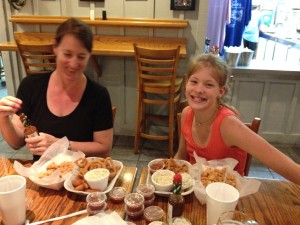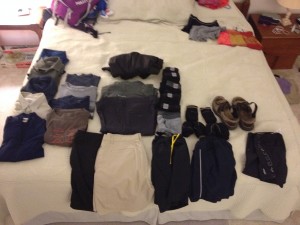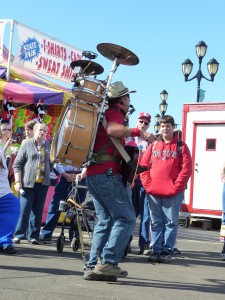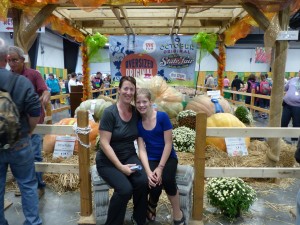The typical piece of clothing in Ecuador:
The way that the girls where their hair is by getting a piece of ribbon and twist it in the hair. After they have done that, you cannot see the hair in the middle of the pony tail but only and inch or two at the bottom. The dress they wear is from their knees to… Well longer. To what I have seen from pictures AND seen myself the tops are white, embroidered with a lot of colors and the skirt ( the bottom part of the dress ) is often times… Well all most all colors. Not on one but there are a lot of different colors. No doubt, you will have the color you want.
All posts by Fourbackpacks
Main Street in the town we teach
First day of school
Monday 27th October
Day one of school… We had breakfast, scrambled eggs, rice and a piece of bread with Piña (pineapple) marmalade.
At 7:15 we were off to school. At the first stop Leendert and I got out. We walked through the courtyard and met with Mathilde Cartagena. She us a charming lady from Isabela originally.
We walked into the first class. Concrete North and South walls, East and West are ½ wood, ½ open to the elements. The roof is corrugated plating. Old furniture from the 70-ies, probably repainted 3 to 5 years ago. One white board, teachers bring their own pens and erasers.
The first class consisted of about 24 kids in ‘free flowing’ uniform. Leendert and I got introduced, and after each kid stood up to say “good morning my name is…” . 20 min later we sat outside on small benches under a tree to help them read and pronounce the words correctly.
After this first class we had a short break and I discussed with Mathilde what was next. She showed the English lab. It was undoubtedly modern in the 70’ies. Cubicles with old headphones but clearly in disrepair.
Class two, after the obligatory intro, Mathilde tried to get a discussion (question and answer) to take place. Lots of laughter, simple exploratory question. Eyes quickly diverted to Leendert, with much giggles from the girls. The session went so well that she abandoned the ‘describe your house’ exercise. Time flew past.
Next we were off to another government school (two blocks away over sandy road). We arrived during their break and awaited the start. Already on the playground it was clear this was a slightly rougher environment.
The forth and final class Leendert sat in the back doing his homework. It took place in a dilapidated language lab, but the group was very smal (about 7 kids) and it was filled will laughter and girls eyeing Leendert again.
Upon return home we had lunch. Lobster soup, followed by rice and some fish & gue which I did not care for too much. After an afternoon nap, we went to the beach. Kids playing in the sand and in the waves, while pelicans kamikaze dive next to them, sea lions play in the vicinity, and a stingray and iguana saying a quick hello.
After a tuna (and rice) dinner we took a small stroll through town and went to bed. Not bad for a first day on Isabel!
Sunday part 2
Sunday 26th October (from Isabela)
After we get breakfast served in our room, and decide to go for a walk to tortuga bay. It proves to be a 2,5km walk of which the first two are over a beautiful laid path, two meters wide through the mangroves. Particularly interesting were the cactus trees. They are true trees, and their inside is like a honeycomb and fibres, such that they can store water. The last 500m are over the beach. A wide, white, flat beach with fine sand over which strolled several sea iguanas. Idillic in many ways. The kids started with walking in the water, but 15 minutes later their clothes are drenched.
As we are on a time schedule, we spend only 15 min at the bay before tracking homeward. We pack our backpacks, pay, and drop our bags in the centre of town where we bought the tickets for the boat. We have a quick lunch, an happy for the Internet connection we up- and download mails and web blogs.
At 13:30 we picked up our bags and walked to the pier. After a baggage check for animals/plants we wait between 60 odd people for our boat: the Julet. Heidi opens the seasick medicine bag, and the kids get acupuncture bracelets, some oil behind the ears and one earplug in the non-dominant ear. We see how many small yellow boats get packed and depart. After a while it is our turn. We get loaded on board and are amazed that the luggage is loosely placed up front.
After about 4 minutes and the request of each of us to pay an additional 50 cents all becomes clear. These yellow boats are merely taxis taking us to the main boats. The Julet is a larger boat with three 175hp engines. Once we are all installed (20 people), and lifejackets handed out we reach open sea. It does not take more than 10 minutes before the first passenger gets sick.
The passage takes a bit over 2 hours, and several people get sick, filling little grey plastic bags handed to them by the shipmate. Part of the discomfort is the smell and the noise of the engines as well that we are sitting in the boat quite packed, hence it is warm.
Heidi feels quite squeezy for a while, and Leendert too looks a bit pale in the middle of the trip. Both fortunately hang in well, and Leendert even perks up towards the end. There is a sense of relief by all once we pull into the harbour.
We transfer again into small boats, which for $1, bring us to terra firms. We go through ‘customs’ and for another $20 we finally are on Isabella. Julio the local English teacher awaits us on the dock, and as we wait for our luggage, see lions play and entertain the kids in the water below us.
A short wait after we get the backpacks, ‘Alfredo’ picks us up. He brings us to what will be our abode for the next 2 weeks. We stay in a sort of hostel ‘flamingo’. One big room with brown tiled floors and two single and one double bed. Julio promises introduces us to the host family, which consists of an elderly couple; one of them is Alfredo.
Julio promises to be back later, right after dinner. The kids jump in the hammocks upfront, and Heidi and I unpack our backpacks and stroll to the local supermarket to buy some drinks. We have fish, rice and beans for dinner, and get introduced to bright orange lemons. Leendert thinks himself in heaven.
Following that we get the tour of the town by Julio. 30 minutes later we have seen the town in all its glory. Tomorrow at 7:15 we are expected to report for duty. Heidi and Alicia will go with Julio, I am to report in another school with Leendert, asking for Mathilde Cartagena. In all honesty, I am a bit nervous. Helping to teach, in a school of 8-14 year olds, a school where even the principle does not speak English,…
.
Sunday 26th October
The little town of Puerto Ayora stays lively till late. Had it not been for earplugs and eye-mask I am sure Heidi would have been up all night. The singing went on till 4am, despite the rain coming down. The rain petered out into a light drizzle around 6:30am, and the sun made an attempt to shine through it, albeit faintly.
While the Internet connection was ok yesterday, it seemed to have abandoned us the evening before and remains unavailable in the morning. The feeling of non-connectivity for more then 12 hours is amazing. While sitting in a simple hotel/guesthouse this electronic aberration makes me feel like we are ‘roughing it’. Total silliness. Surrounded by a stove, coffee pot, a fridge and an old, old TV the lack of Internet seems to define my Robinson Cruso sense of being isolated. Perhaps I am also influenced by the fact that I just finished the book Floreana, which describes the first settlement of the so named Galapagos island. Either way, as we go to Isabella I am sure matters won’t improve!
As the rest of the family awakens, Heidi puts together the cost spreadsheet and the study plan for Leendert.
NOTE: we are about to leave Santa Cruz. It is our expectation that we will have less connection on Isabella island. We’ll drop a message as soon as we can.
Arrived Quito – all is well
Good news. After a painful early wake up and our goodbyes to the grandparents, we had a good flight via Miami to Quito. All backpacks made it in one piece. Flights connected and were on time.
Quito, formally San Francisco de Quito, is the capital city of Ecuador, and at an elevation of 9,350 feet (2850m), it is the highest official capital city in the world (though La Paz, Bolivia seems to claim this as well).
It derives its name from the Quitus, who inhabited the region even before the Incas, way before the Spanish came.
Pickup awaited us at the terminal, and we got to our hotel 60 min after arrival. We met up with our contact Jorge, and made appointment for evening tour.
We had a quick (very late) lunch in a local restaurant, lots of taco’s, corn chips, rice and beers.
A bit light headed because of the altitude we saw the sited of the city at night. Spanish, colonial, and many churches. At the Calle de la Ronda we tried some local foods and local drinks.
The last stop was at La Vírgen del Panecillo. She is a huge ‘winged virgin mary’, is made out of aluminium and stands on a large hill on top. Evidently one should not walk the hill as it is gang controlled and thus dangerous.
Back at the hotel we crashed, and Leendert predicted he was going to do some ‘extreme sleeping’.
Journal of the first day. 17/10/2014
Mom came to wake us up for the long day. 25 hours and a half. She came up to me and said in almost a whisper
” Alicia, time to get…” She had no time to finish the sentence because I was awake and I jumped in to her arms. At one moment, I was thinking that she was going to have a heart attack but that did not happen.
“Are you going to wake Leendert up now?” I asked hopping she would say yes.
“No, he has been up since 6:30.” She answered. I got up and got everything I could do without hurting my heel.
“Let’s go to lunch.” Mom said happily.
“You mean breakfast, right?” I asked. She rolled her eyes, sighed her happy sight and nodded. I could not help a giggle after Leendert started to laugh. We laughed a little but mom shushed us that other people might be sleeping now.we let out one more laugh and got quiet like mom had told us. My happiness in that moment was never to forget. I still had some time before we where going to go to breakfast. I plopped down on to the bed I was sleeping in and took the book that was next to me. The book was about things around the world. I had gotten it the day before, that was the last day of school for the year, the teachers gave it to me to say good bye. The best is that they all signed it.
“Come on. We should get some breakfast now. We will be leaving soon.” Mom told us before I could open the book. I put it away in a bag and went out the room wile tying my hair in a pony tale.
Countdown from the Cary Launchpad
Tomorrow 4:30 am departure – the real voyage starts.
couple of last moment delights – Fish in the nr 1 place in NC,…. A delight of fried onion rings, fried shrimp, and fried fish,…
But most importantly, the bag packs got packed. The fall colours for AvtR are blue and grey. What you see on the bed is all the clothes for 8 months,….
Alicia’s clothes for 8 months below – bit more colourful…. (notice Piet the cat on the right side – he’ll be the trusted travel companion).
First North Carolina instrument
Playing the bagpipe
So, if you have looked at the video (and hopefully not put it as loud as you could), it is very impressive. Playing it is harder than you think it is. You can make it easier by NOT being with your family. Like the violin, it is louder next to your ear than at a couple feet away. Like a tuba or a trumpet, it needs a reed and a mouth piece. Getting it ready you put it together like most of the other instruments. If the talking was unclear or you heard more than what I could hear listening, I had asked:
“Why are there two times the same note?” To what he said that there would not be enough sound otherwise. The best place to play the bagpipe, one of the old ones is where it is 12-20 degrees Celsius. If the heat is to hight, it would be able to cracks them but to cold or to humid will get water on to the reed and it will not make any sound.
Absorbing American Culture
A good part of the day spend at the North Carolina State fair.
Incredible rides, massive pumpkins (winner at about 1500 pounds), beautiful animals, a one man band, and some culinary delights that are to die for (?). It is amazing what one can fry in this part of the world,… read the photo of the sign.









